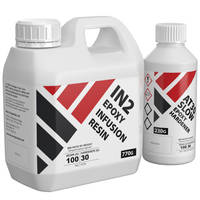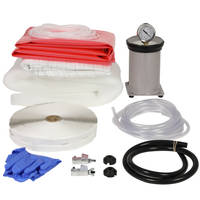Heb je hulp of advies nodig?+44 (0)1782 454499
PRODUCTEN GEBRUIKT IN DIT PROJECT
Hoewel dit niet per se een uitputtende lijst is, werden de volgende gereedschappen en materialen, geleverd door Easy Composites, in dit project gebruikt.
De hoeveelheid die hieronder wordt weergegeven, is de geschatte hoeveelheid die in het project wordt gebruikt, afgerond naar de dichtstbijzijnde beschikbare kitgrootte of hoeveelheid.
VERSTERKINGEN
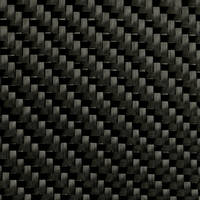
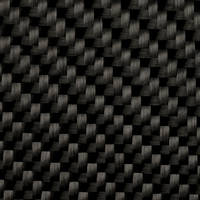
INFUSIEAPPARATUUR & VERBRUIKSARTIKELEN
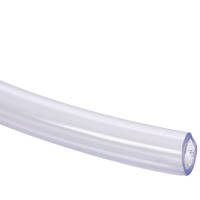
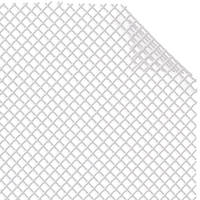
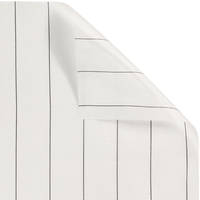
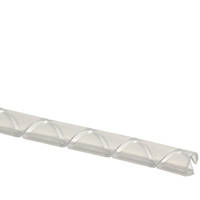
VERBRUIKSARTIKELEN VOOR VACUÜMZAKKEN
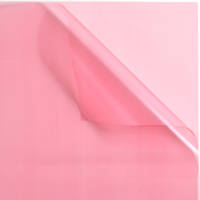
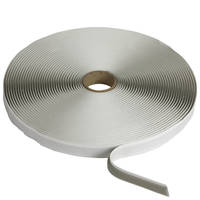
GEREEDSCHAP & UITRUSTING
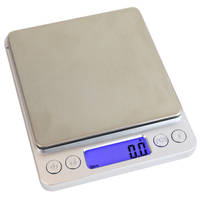
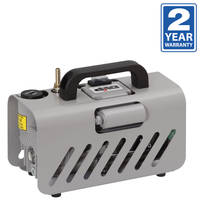
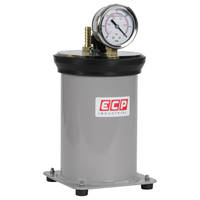
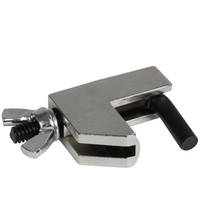
MATERIALEN & VERBRUIKSARTIKELEN
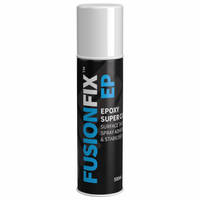
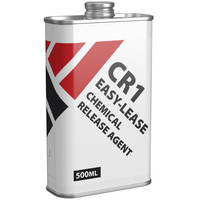
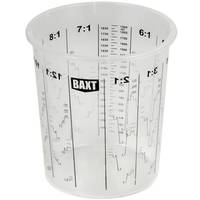
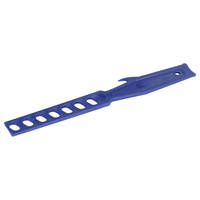
VIDEO HANDLEIDING
Beginnersgids voor Koolstofvezel-Harsinfusie
Voor professioneel en hoogwaardige onderdelen is harsinfusie een van de belangrijkste methoden om deze onderdelen te maken. Het levert uitstekende prestaties en lichtgewicht onderdelen op met een minimale hoeveelheid specialistische apparatuur en kan worden uitgehard bij kamertemperatuur.
In deze gids voor harsinfusie komen onder andere de volgende onderwerpen aan bod:
- Hoe infusie werkt
- Benodigde materialen
- Geschikte matrijstypes
- Leggen van de koolstofvezel
- Infuus Stack
- Het infuus uitvoeren
- Ontvormen en afwerken
UITSPLITSING TUTORIAL
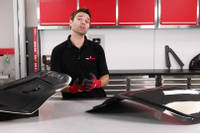
1. Procesoverzicht
Het proces van harsinfusie kan als volgt worden samengevat: de vezels worden droog in de mal geplaatst. De mal wordt vervolgens vacuüm gezogen en er wordt een vacuüm getrokken waardoor de lucht uit de zak wordt gezogen. De hars wordt dan door het vacuüm in de mal getrokken en verzadigt alle vezels. Het onderdeel kan dan uitharden bij kamertemperatuur.
Goed gemaakte geïnfuseerde onderdelen hebben een perfecte harsvezelverhouding en zullen mechanisch zeer goed presteren. Ze hebben het voordeel dat ze zowel cosmetisch als mechanisch superieur zijn aan handgemaakte onderdelen. En omdat de hars aan het eind van het proces wordt ingebracht, is het zeer schoon en ingesloten.

2. Apparatuur en materialen overzicht
Het gebruik van de juiste materialen en apparatuur is essentieel om de infusie succesvol uit te voeren. Als je eenmaal een mal hebt gemaakt, is dit een lijst met de basismaterialen en verbruiksmaterialen die worden gebruikt bij het infusieproces:
- Weefselversterking - Meestal koolstofvezel, maar er kunnen ook verschillende geweven materialen worden gebruikt.
- Spuitlijm - Behalve voor zeer platte mallen, gebruikt om de stof te positioneren en op zijn plaats te houden.
- Infusiehars - Hars met een lage viscositeit helpt bij het vloeien en bevochtigen van de vezels.
- PP180 Peel Ply - Laat hars door en kan gemakkelijk worden verwijderd van het afgewerkte onderdeel.
- FM100 Infusion Mesh - creëert stroomkanalen voor de hars over het weefseloppervlak.
- Harsinfusiespiraal - Creëert een snel stromend harskanaal voor het verdelen van hars.
- Aansluiting voor infusiesiliconen - Gebruikt voor zowel harsinlaat- als vacuümaansluitingen.
- VB160 Vacuümzakfolie - folie van 50 micron die wordt gebruikt om de zak zelf te maken.
- ST150 Zakkensluitband - Gebruikt om de vacuümzak aan de vormflenzen vast te maken.
- PVC-slang - Wegwerpslang voor harstoevoer en vacuümleidingen.
Een van de voordelen van harsinfusie is dat er niet veel apparatuur nodig is om het proces succesvol te voltooien. De volgende items zijn de gebruikelijke benodigdheden:
- Vacuümpomp - Geschikt voor een vacuümniveau van 5 mbar (~99,5%) of beter.
- Opvangbak - Nodig om hars op te vangen dat uit de zak komt om de pomp te beschermen.
- Lijnklemmen - Gebruikt om hars toevoer- en vacuümleidingen af te klemmen.
- Lossingsmiddel - Voorkomt dat onderdelen aan de mal blijven plakken.
- Mengemmers & -stokjes - Voor het vasthouden en mengen van hars.
- Nitril handschoenen - PBM's om handen te beschermen.
- Digitale weegschaal - Voor het nauwkeurig afmeten van hars en verharder.
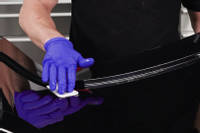
3. De mal voorbereiden
Voor het proces heb je een geschikte mal nodig. Meestal worden deze gemaakt door een mal te nemen van het originele onderdeel of een patroon. Een belangrijk punt om op te merken is dat voor harsinfusie een grotere flens nodig is om ruimte te bieden voor het opvulproces en de opvulstapel. Meestal is ongeveer 100 mm (4") genoeg. Het is mogelijk om een kleinere flens te gebruiken, maar dat maakt het leggen moeilijker.
Het infusieproces vindt plaats bij kamertemperatuur, wat betekent dat je een grotere keuze hebt in matrijsmaterialen. Over het algemeen raden we het Uni-Mould Tooling System aan vanwege de grote waarde en het gebruiksgemak. Je kunt hier een instructievideo bekijken van het Uni-Mould System: Uni-Mould Tooling Systeem Gebruikershandleiding
In dit stadium wordt het lossingsmiddel aangebracht. Wij raden een chemisch lossingsmiddel aan, zoals onze CR1, voor een superieure lossing. De ST150 gomtape wordt dan rond de flenzen aangebracht terwijl de flenzen schoon en vrij van losse vezels zijn. De mal is dan klaar voor gebruik.
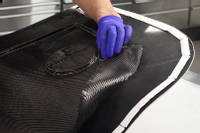
4. De wapening leggen
Voor dit specifieke onderdeel wordt het 210 g twill carbonweefsel gebruikt voor de oppervlaktelaag. Als achterkant wordt één laag koolstofvezel van 650 g gebruikt, omdat die dezelfde dikte heeft als ongeveer 3 lagen van het 210 g doek. De doeken worden vervolgens uitgesneden, waarbij ongeveer 100 mm extra wordt aangehouden voor plaatsingsfouten.
De vezel wordt dan op de mal geplaatst met een beetje Fusion Fix EP om hem op zijn plaats te houden. Doe dit voor beide lagen en zorg ervoor dat de vezels goed in de hoeken en details worden gedrukt.
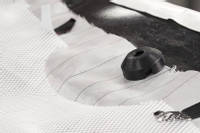
5. Verbruiksartikelen voor infusen
Vanaf dit punt is het proces nu gericht op het vergemakkelijken van het infusieproces. Dit omvat het maken van de stapel zakken door de infusiehulpstoffen in de mal te leggen.
Het eerste deel van de stapel is de peel ply. Daarna volgt het infusiegaas waardoor de hars over het onderdeel kan stromen. Als het gaas eenmaal naar beneden is, is het belangrijk om te bedenken waar je de infusieconnectoren en infusiespiraal wilt plaatsen voor de beste stroming van de hars om ervoor te zorgen dat het onderdeel volledig wordt geïnfuseerd. Als je de regels in de demonstratie en de getoonde voorbeelden volgt, moet het eenvoudig mogelijk zijn om de beste manier te plannen om ervoor te zorgen dat het onderdeel volledig met hars wordt bevochtigd.
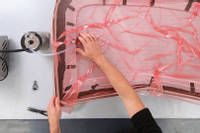
6. Verzegelen en vacuümzak naar beneden trekken
Een zeer hoog vacuümniveau is essentieel om het infusieproces te laten werken, wat betekent dat het vacuümzakken de meest kritische fase van de lay-up is. Het is essentieel om een lekvrije zak te krijgen en je mag pas met het infuseren beginnen als de zak lekdicht is. We hebben een specifieke video over het maken van een gesealde vacuümzak die je hier kunt bekijken: Hoe zoek, repareer en voorkom je lekken in vacuümzakken?
De folie wordt op de flens van de mal geplooid, zodat er voldoende folie overblijft om alle details te vullen zonder dat er bruggen ontstaan. De PVC-slang wordt vervolgens in de Infusion Silicone Connectors gestoken en vastgezet met gomtape. De slang kan op de pomp worden aangesloten en het vacuüm kan op de zak worden getrokken, waarbij de folie zo nodig wordt aangepast. Vervolgens kan de druppeltest worden uitgevoerd om te controleren of de zak lekvrij is.
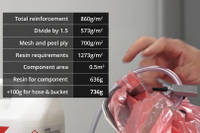
7. Hoeveelheid hars berekenen
Nu zijn we klaar om de hars te mengen en de infusie zelf uit te voeren. Om de benodigde hoeveelheid hars te berekenen, bereken je eerst het gewicht van de layup per vierkante meter. Zodra dit getal bekend is, wordt het gedeeld door 1,5 om de werkelijke hoeveelheid hars te krijgen die nodig is in het laminaat. 700 g per vierkante meter wordt toegevoegd om rekening te houden met het harsverbruik van de schillen en het gaas.
Dat geeft dan de totale hoeveelheid hars per vierkante meter. Dit getal wordt dan vermenigvuldigd met het oppervlak van de mal om de werkelijke hoeveelheid te krijgen die nodig is voor de grootte van de mal. Er wordt dan 100 g toegevoegd aan dat totaal om rekening te houden met hars in de slangen en de bodem van de hars-toevoerpot.
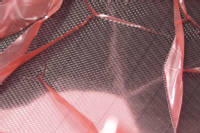
8. Het infuus uitvoeren
In dit stadium is de infusie zelf klaar om uitgevoerd te worden. De juiste hoeveelheid hars wordt afgemeten en grondig gemengd. De slang wordt in de mengemmer gestoken en met tape vastgezet om beweging te voorkomen.
De infusiehars kan nu stromen - open de lijnklem langzaam zodat de hars tot aan de klem kan stromen, open dan na een paar seconden zodat de lucht uit de slang kan stromen, volledig en laat de hars in het onderdeel stromen en over het laminaat infuseren.
Zodra de hars volledig is ingetrokken en in de slang van de vacuümleiding stroomt, kan de vacuümleiding volledig worden afgeklemd. De harsinvoer wordt dan korte tijd open gelaten om wat meer hars toe te laten - om de cosmetische afwerking te verbeteren. De harsaanvoerleiding kan dan volledig worden afgeklemd en de mal en het onderdeel moeten 24 uur uitharden.
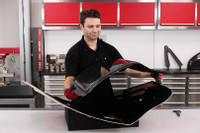
9. Demould
Om te controleren of het onderdeel klaar is voor ontmallen, buigt u de harsslang - als hij klaar is, moet hij netjes knappen - zo niet, wacht u langer. De vacuümzak kan dan worden verwijderd. De peel ply en het gaas worden verwijderd door de randen af te knippen en in stroken van 100 mm breed te trekken. Daarna kan het onderdeel worden ontvormd met behulp van ontvormwiggen.
De hoge kwaliteit van de matrijs heeft geleid tot een hoogwaardig afgewerkt onderdeel en met het correct voltooide infusieproces tot een vlekkeloze afwerking zonder gaatjes. Het onderdeel is vervolgens bijgesneden en afgewerkt, klaar voor gebruik. Het afgewerkte onderdeel weegt minder dan een kwart van het oorspronkelijke onderdeel.
DISCUSSIE (14)
Laat het ons weten als je vragen of opmerkingen hebt over deze videotutorial.
Ja, als je de tabel of formule gebruikt, is de hoeveelheid de gecombineerde mix van hars en verharder.
Het ziet er goed uit, gewoon een donkergrijze kleur stevig materiaal. Je kunt de snijrand probleemloos schuren, vlak maken en polijsten.
We hebben er geen video over, nee. Het heeft er vooral mee te maken dat de druk in de zak iets afneemt, waardoor het volume van de achtergebleven lucht aanzienlijk afneemt. De hars wordt naar binnen getrokken door de elastische spanning in de zak en het gaas. De harsopname tijdens deze fase is minimaal (misschien 10-20 g op een onderdeel als dit), maar je krijgt meestal een betere oppervlakteafwerking omdat de micro-luchtbellen krimpen. Misschien kunnen we er in de toekomst meer in detail naar kijken.
Hoi Mike, je hebt je 914 omgebouwd naar elektrisch! Geweldig project. Een carbon Targo-top zou daar zeker goed bij passen. Je hebt helemaal gelijk dat de bevestigingsmiddelen en de nauwkeurigheid het lastigste deel zouden zijn. Niet onmogelijk, maar een Targa-dak is ingewikkelder dan een conventioneel statisch carrosseriepaneel. Ik hoop dat het je lukt, en neem zeker contact op met ons technisch team als je advies nodig hebt over materiaal- of proceskeuze. Ik wens je er veel succes mee.
De enige keer dat het voordelig is om een mal van koolstofvezel te maken, is wanneer je een proces met hoge temperatuur gebruikt (zoals prepreg) en je koolstofvezelonderdelen maakt. De reden hiervoor is dat bij temperatuur de CTE van het materiaal (de mal en het onderdeel) echt belangrijk is. Het is voordelig om een mal te hebben die dezelfde thermische uitzetting heeft als het onderdeel dat je erin gaat maken. Voor processen bij kamertemperatuur is er echter niet echt een voordeel aan een mal van koolstof. Wat wel een voordeel zou kunnen zijn, is een harssysteem met lage tot geen krimp. Uni-Mould (zoals de mal die in deze video wordt gebruikt) heeft een zeer lage krimp en een epoxy mal heeft een nog lagere krimp. De krimp van de hars maakt dus veel meer uit dan de wapening, voor processen op kamertemperatuur.
De beste oplossing is een hoogwaardige 2k autolak. We zullen binnenkort een product op voorraad hebben dat Fantom Clear heet en dat zo'n product is, maar er zijn er nog meer, zowel in speciale 2k blikken (het type dat je moet activeren en dan binnen 48 uur moet gebruiken) als in spuitpistolen. Hoewel we een blanke gelcoat hebben die erg goed presteert op het gebied van UV-stabiliteit op de lange termijn, is dit over het algemeen niet de manier die we zouden kiezen om een dagelijks gebruikt 'carbon look' onderdeel af te werken, omdat het moeilijker te repareren of te herstellen is.
Ja, als je de harsstroomafstanden binnen de regels van de video kunt krijgen (of van harssysteem kunt veranderen als dat niet lukt) dan zou je de meeste vormen moeten kunnen infuseren. Het hangt af van de afmetingen en verhoudingen van deze kegelvorm, maar (mogelijk met wat vallen en opstaan) zou het mogelijk moeten zijn.
Galvanische corrosie' is een type corrosie dat optreedt wanneer twee ongelijksoortige materialen, met specifieke eigenschappen, in direct contact met elkaar komen in aanwezigheid van een elektrolyt. In een koolstofvezelcontext is galvanische corrosie een probleem wanneer koolstofvezel in direct contact komt met aluminium in de aanwezigheid van zout water. Het is alleen een probleem als al deze dingen aanwezig zijn. Voor koolstofvezel voertuigpanelen is het risico alleen echt aanwezig wanneer je koolstofvezelpanelen direct op aluminium beugels of een aluminium subframe lijmt en vervolgens het voertuig gebruikt op een manier die deze gebieden regelmatig blootstelt aan zout water (zoals de Britse winterwegen). Gelukkig is de oplossing vrij eenvoudig en moet je ervoor zorgen dat koolstofvezel niet in direct contact komt met aluminium, meestal door een of twee lagen glasversterking toe te voegen tussen koolstofvezel en aluminium onderdelen wanneer je ze direct aan elkaar verbindt.
De gewichtsbesparing kan groot zijn in vergelijking met originele OEM-onderdelen. Op een R8 is dit een cosmetisch sierpaneel, dus beide vervangen op een circuit-/raceauto is alleen al een besparing van bijna 6 kg!
Ja, je kunt het IN2 harssysteem naharden. Als het praktisch is om dat te doen, wordt het over het algemeen als een goed idee beschouwd. Uitharding na uitharding verbetert de mechanische prestaties met een paar procent en verhoogt de Tg (temperatuurtolerantie) van de component. Het kan ook de uitharding versnellen, wat erg nuttig kan zijn bij de productie van grote volumes. Raadpleeg het technische gegevensblad van het IN2-hars voor de voorgestelde uithardingscycli.
Dat hangt af van de afdruk. De meeste afdrukken hebben een hoge porositeit en een relatief lage druksterkte, dus ze kunnen worden geplet of er kan veel hars in trekken. Een hoog invulniveau op de print kan dat verminderen. Uiteraard moet de buitenkant worden gladgeschuurd en daarna kan deze het beste worden gelakt met een UV-stabiele blanke lak.
We hebben een product dat GC50 heet en speciaal voor dit doel is ontworpen. Het is een epoxy-compatibele polyester gelcoat die alleen is ontworpen om op deze manier te worden gebruikt. Omdat het polyester is, is het vrijwel perfect UV-stabiel; het epoxy-compatibele gedeelte betekent dat het hard en glad uithardt op het open oppervlak, klaar voor de epoxy om zich eraan te hechten (in plaats van te blijven plakken zoals conventionele polyester gelcoats doen). De voordelen van een in-mould coating zijn duidelijk (geen gevreesde sinaasappelhuid als je spuitwerk niet goed is), maar de nadelen zijn een kleine verandering in het uiterlijk van het carbon, vooral als je harsinfusie doet, omdat de in-mould coating zelf een lichte textuur krijgt en deze textuur wordt overgedragen op de koolstofvezel, en ook als er iets misgaat met de infusie (een droge plek hier of daar) dan kun je het gemakkelijk oplappen en er dan overheen spuiten als je geen in-mould coating hebt, maar als je die wel hebt, is het veel moeilijker te herstellen.
Het zou zeker een uitdaging zijn, maar niet onmogelijk, om zo'n maat en vorm als een mal uit één stuk te maken. Je hebt zeker een gedeelde mal nodig, zoals je beschrijft. Ervan uitgaande dat de deuropening groot genoeg is om naar binnen te werken, zou ik het geheel waarschijnlijk omdraaien zodat de deur/scharnier aan de onderkant zit; veel gemakkelijker om op die manier te werken en je staat niet op de versteviging als je naar binnen en naar buiten gaat.
Dan hangt het af van het proces dat je wilt gebruiken. Prepreg zou gemakkelijker te lamineren zijn, maar dan moet je de hele structuur van meer dan 8 m in de oven kunnen uitharden, wat waarschijnlijk niet praktisch is, en dus blijf je over met harsinfusie (mechanisch beter, maar ingewikkelder om in te stellen) of een conventionele natte lay-up. Ervan uitgaande dat je op zoek bent naar de beste prestaties, betekent dat infusie. Om dit te doen moet je eerst de naden op de splitsingen vasttapen (zodat ze luchtdicht zijn) en dan de wapening erin leggen; je hebt een behoorlijke hoeveelheid spuitlijm nodig om het ondersteboven in een cilinder te houden. De harsstroom zal veel gecompliceerder zijn en moeilijk te voorspellen op deze vorm, dus je zult microporeuze membranen moeten gebruikenDD Compound MTI slang etc.) om de luchtstroom in stand te houden en droge plekken te voorkomen. Dan moet het geheel in een enorme zak die bijna zeker een enveloppezak moet zijn (dus je doet de binnen- en buitenkant van de mal in zakken, als een gigantische langwerpige donut!
Als je het project serieus neemt, neem dan contact op met ons technisch team, zodat we je meer gedetailleerd advies kunnen geven over producten en processen. En, veel succes ermee!
Bedankt voor het commentaar, dit is een zeer interessante vraag en verdient absoluut een eigen video, een spotlight of mogelijk het hoofdkanaal omdat het een belangrijk onderdeel is van veel projecten. Samengevat laat FusionFix EP wel een residu achter, maar dat is niet zichtbaar en niet gemakkelijk te verwijderen. Sterke oplosmiddelen (zoals aceton) kunnen het residu verwijderen dat een zeer vage 'dither' achterlaat op het oppervlak. Voor de meeste onderdelen in de meeste omstandigheden denken we dat je niets hoeft te doen (d.w.z. gewoon laten zoals het is), wat een game changer is. Als je dacht dat het onderdeel blootgesteld zou kunnen worden aan sterke oplosmiddelen (zoals aceton), dan zou je het residu willen verwijderen. Maar om eerlijk te zijn, moet je waarschijnlijk denken in termen van een sterkere coating voor onderdelen die hoe dan ook worden blootgesteld aan agressieve chemicaliën/oplosmiddelen.
LAAT EEN OPMERKING OF VRAAG ACHTER
PRODUCTEN GEBRUIKT IN DIT PROJECT
Hoewel dit niet per se een uitputtende lijst is, werden de volgende gereedschappen en materialen, geleverd door Easy Composites, in dit project gebruikt.
De hoeveelheid die hieronder wordt weergegeven, is de geschatte hoeveelheid die in het project wordt gebruikt, afgerond naar de dichtstbijzijnde beschikbare kitgrootte of hoeveelheid.
VERSTERKINGEN


INFUSIEAPPARATUUR & VERBRUIKSARTIKELEN




VERBRUIKSARTIKELEN VOOR VACUÜMZAKKEN


GEREEDSCHAP & UITRUSTING




MATERIALEN & VERBRUIKSARTIKELEN




DISCUSSIE (14)
Laat het ons weten als je vragen of opmerkingen hebt over deze videotutorial.
Ja, als je de tabel of formule gebruikt, is de hoeveelheid de gecombineerde mix van hars en verharder.
Het ziet er goed uit, gewoon een donkergrijze kleur stevig materiaal. Je kunt de snijrand probleemloos schuren, vlak maken en polijsten.
We hebben er geen video over, nee. Het heeft er vooral mee te maken dat de druk in de zak iets afneemt, waardoor het volume van de achtergebleven lucht aanzienlijk afneemt. De hars wordt naar binnen getrokken door de elastische spanning in de zak en het gaas. De harsopname tijdens deze fase is minimaal (misschien 10-20 g op een onderdeel als dit), maar je krijgt meestal een betere oppervlakteafwerking omdat de micro-luchtbellen krimpen. Misschien kunnen we er in de toekomst meer in detail naar kijken.
Hoi Mike, je hebt je 914 omgebouwd naar elektrisch! Geweldig project. Een carbon Targo-top zou daar zeker goed bij passen. Je hebt helemaal gelijk dat de bevestigingsmiddelen en de nauwkeurigheid het lastigste deel zouden zijn. Niet onmogelijk, maar een Targa-dak is ingewikkelder dan een conventioneel statisch carrosseriepaneel. Ik hoop dat het je lukt, en neem zeker contact op met ons technisch team als je advies nodig hebt over materiaal- of proceskeuze. Ik wens je er veel succes mee.
De enige keer dat het voordelig is om een mal van koolstofvezel te maken, is wanneer je een proces met hoge temperatuur gebruikt (zoals prepreg) en je koolstofvezelonderdelen maakt. De reden hiervoor is dat bij temperatuur de CTE van het materiaal (de mal en het onderdeel) echt belangrijk is. Het is voordelig om een mal te hebben die dezelfde thermische uitzetting heeft als het onderdeel dat je erin gaat maken. Voor processen bij kamertemperatuur is er echter niet echt een voordeel aan een mal van koolstof. Wat wel een voordeel zou kunnen zijn, is een harssysteem met lage tot geen krimp. Uni-Mould (zoals de mal die in deze video wordt gebruikt) heeft een zeer lage krimp en een epoxy mal heeft een nog lagere krimp. De krimp van de hars maakt dus veel meer uit dan de wapening, voor processen op kamertemperatuur.
De beste oplossing is een hoogwaardige 2k autolak. We zullen binnenkort een product op voorraad hebben dat Fantom Clear heet en dat zo'n product is, maar er zijn er nog meer, zowel in speciale 2k blikken (het type dat je moet activeren en dan binnen 48 uur moet gebruiken) als in spuitpistolen. Hoewel we een blanke gelcoat hebben die erg goed presteert op het gebied van UV-stabiliteit op de lange termijn, is dit over het algemeen niet de manier die we zouden kiezen om een dagelijks gebruikt 'carbon look' onderdeel af te werken, omdat het moeilijker te repareren of te herstellen is.
Ja, als je de harsstroomafstanden binnen de regels van de video kunt krijgen (of van harssysteem kunt veranderen als dat niet lukt) dan zou je de meeste vormen moeten kunnen infuseren. Het hangt af van de afmetingen en verhoudingen van deze kegelvorm, maar (mogelijk met wat vallen en opstaan) zou het mogelijk moeten zijn.
Galvanische corrosie' is een type corrosie dat optreedt wanneer twee ongelijksoortige materialen, met specifieke eigenschappen, in direct contact met elkaar komen in aanwezigheid van een elektrolyt. In een koolstofvezelcontext is galvanische corrosie een probleem wanneer koolstofvezel in direct contact komt met aluminium in de aanwezigheid van zout water. Het is alleen een probleem als al deze dingen aanwezig zijn. Voor koolstofvezel voertuigpanelen is het risico alleen echt aanwezig wanneer je koolstofvezelpanelen direct op aluminium beugels of een aluminium subframe lijmt en vervolgens het voertuig gebruikt op een manier die deze gebieden regelmatig blootstelt aan zout water (zoals de Britse winterwegen). Gelukkig is de oplossing vrij eenvoudig en moet je ervoor zorgen dat koolstofvezel niet in direct contact komt met aluminium, meestal door een of twee lagen glasversterking toe te voegen tussen koolstofvezel en aluminium onderdelen wanneer je ze direct aan elkaar verbindt.
De gewichtsbesparing kan groot zijn in vergelijking met originele OEM-onderdelen. Op een R8 is dit een cosmetisch sierpaneel, dus beide vervangen op een circuit-/raceauto is alleen al een besparing van bijna 6 kg!
Ja, je kunt het IN2 harssysteem naharden. Als het praktisch is om dat te doen, wordt het over het algemeen als een goed idee beschouwd. Uitharding na uitharding verbetert de mechanische prestaties met een paar procent en verhoogt de Tg (temperatuurtolerantie) van de component. Het kan ook de uitharding versnellen, wat erg nuttig kan zijn bij de productie van grote volumes. Raadpleeg het technische gegevensblad van het IN2-hars voor de voorgestelde uithardingscycli.
Dat hangt af van de afdruk. De meeste afdrukken hebben een hoge porositeit en een relatief lage druksterkte, dus ze kunnen worden geplet of er kan veel hars in trekken. Een hoog invulniveau op de print kan dat verminderen. Uiteraard moet de buitenkant worden gladgeschuurd en daarna kan deze het beste worden gelakt met een UV-stabiele blanke lak.
We hebben een product dat GC50 heet en speciaal voor dit doel is ontworpen. Het is een epoxy-compatibele polyester gelcoat die alleen is ontworpen om op deze manier te worden gebruikt. Omdat het polyester is, is het vrijwel perfect UV-stabiel; het epoxy-compatibele gedeelte betekent dat het hard en glad uithardt op het open oppervlak, klaar voor de epoxy om zich eraan te hechten (in plaats van te blijven plakken zoals conventionele polyester gelcoats doen). De voordelen van een in-mould coating zijn duidelijk (geen gevreesde sinaasappelhuid als je spuitwerk niet goed is), maar de nadelen zijn een kleine verandering in het uiterlijk van het carbon, vooral als je harsinfusie doet, omdat de in-mould coating zelf een lichte textuur krijgt en deze textuur wordt overgedragen op de koolstofvezel, en ook als er iets misgaat met de infusie (een droge plek hier of daar) dan kun je het gemakkelijk oplappen en er dan overheen spuiten als je geen in-mould coating hebt, maar als je die wel hebt, is het veel moeilijker te herstellen.
Het zou zeker een uitdaging zijn, maar niet onmogelijk, om zo'n maat en vorm als een mal uit één stuk te maken. Je hebt zeker een gedeelde mal nodig, zoals je beschrijft. Ervan uitgaande dat de deuropening groot genoeg is om naar binnen te werken, zou ik het geheel waarschijnlijk omdraaien zodat de deur/scharnier aan de onderkant zit; veel gemakkelijker om op die manier te werken en je staat niet op de versteviging als je naar binnen en naar buiten gaat.
Dan hangt het af van het proces dat je wilt gebruiken. Prepreg zou gemakkelijker te lamineren zijn, maar dan moet je de hele structuur van meer dan 8 m in de oven kunnen uitharden, wat waarschijnlijk niet praktisch is, en dus blijf je over met harsinfusie (mechanisch beter, maar ingewikkelder om in te stellen) of een conventionele natte lay-up. Ervan uitgaande dat je op zoek bent naar de beste prestaties, betekent dat infusie. Om dit te doen moet je eerst de naden op de splitsingen vasttapen (zodat ze luchtdicht zijn) en dan de wapening erin leggen; je hebt een behoorlijke hoeveelheid spuitlijm nodig om het ondersteboven in een cilinder te houden. De harsstroom zal veel gecompliceerder zijn en moeilijk te voorspellen op deze vorm, dus je zult microporeuze membranen moeten gebruikenDD Compound MTI slang etc.) om de luchtstroom in stand te houden en droge plekken te voorkomen. Dan moet het geheel in een enorme zak die bijna zeker een enveloppezak moet zijn (dus je doet de binnen- en buitenkant van de mal in zakken, als een gigantische langwerpige donut!
Als je het project serieus neemt, neem dan contact op met ons technisch team, zodat we je meer gedetailleerd advies kunnen geven over producten en processen. En, veel succes ermee!
Bedankt voor het commentaar, dit is een zeer interessante vraag en verdient absoluut een eigen video, een spotlight of mogelijk het hoofdkanaal omdat het een belangrijk onderdeel is van veel projecten. Samengevat laat FusionFix EP wel een residu achter, maar dat is niet zichtbaar en niet gemakkelijk te verwijderen. Sterke oplosmiddelen (zoals aceton) kunnen het residu verwijderen dat een zeer vage 'dither' achterlaat op het oppervlak. Voor de meeste onderdelen in de meeste omstandigheden denken we dat je niets hoeft te doen (d.w.z. gewoon laten zoals het is), wat een game changer is. Als je dacht dat het onderdeel blootgesteld zou kunnen worden aan sterke oplosmiddelen (zoals aceton), dan zou je het residu willen verwijderen. Maar om eerlijk te zijn, moet je waarschijnlijk denken in termen van een sterkere coating voor onderdelen die hoe dan ook worden blootgesteld aan agressieve chemicaliën/oplosmiddelen.
LAAT EEN OPMERKING OF VRAAG ACHTER
100% BEVEILIGD
BETALINGSMETHODEN
Easy Composites EU B.V., geregistreerd in Nederland 73601195. Alle inhoud auteursrechtelijk beschermd (C) Easy Composites Ltd, 2025. Alle rechten voorbehouden.
